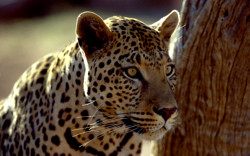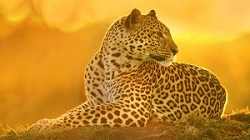The leopard (Panthera pardus)is by far the most graceful and definitely one of the most stunning of all the large African cats. Being shy and hard-to-find leopard is a master of survival and silent stealth. A very strong climber, it can carry prey double its own body weight up into a tree with ease.
This is generally always done to protect its kill from lions and hyenas,
who will always try and steal it away.

It has been recorded many times, that either lion and hyena will watch a
leopard from a distance, and as soon as the leopard made its kill, they
would storm the leopard to chase it away and steal the leopard's prey.
Leopards do not easily get into fights with lions or hyenas, as both these
formidable predators cold cause serious damage to an leopard, and a hurt
leopard do not hunt easily.
Of all the big predators, leopard are the most successful hunter, so it will
not easily defend its kill. Easier to leave it and hunt again.
Once a leopard got its prey up into an tree, it will eat from it for days
till it is all finished, even if the meat gets really rotten.
Leopards are generally night creatures and usually hunt well after dusk. It
is not easy to spot a leopard as their natural camouflage, make them
disappear with ease.
Leopards prey on a wide range of critters varying from rodents, insects,
birds, hyrax to larger animals, even kudu that is twice their weight and
size.
In spite of intense persecution of leopards, they still survive in remote
areas around the world. Here in Africa, they are sometimes even able to
re-colonise new areas. How-ever, leopards have disappeared from many regions
in Africa.
Their saving grace, is their ability to adept to their environment, but they
are still considered an endangered species, due to the illegal trade in
their skins.
Southern Africa has still the largest concentration of leopards, and
numerous Game Reserves and National Parks offers sanctuary to these
beautiful cats. In South Africa, Namibia and Botswana there are various
safari tours that
offer the rare chance to see them in a natural environment.

